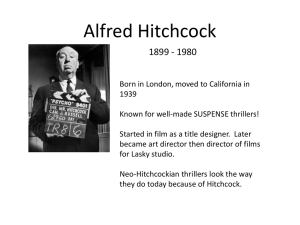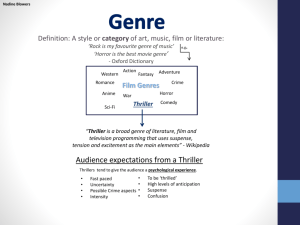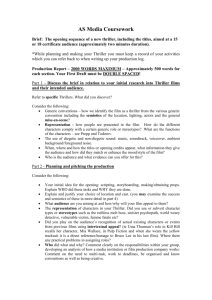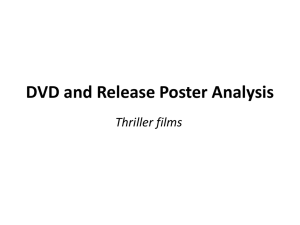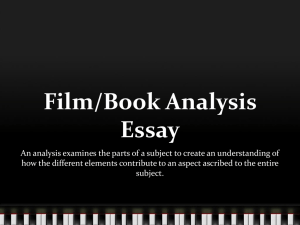The Thriller
advertisement
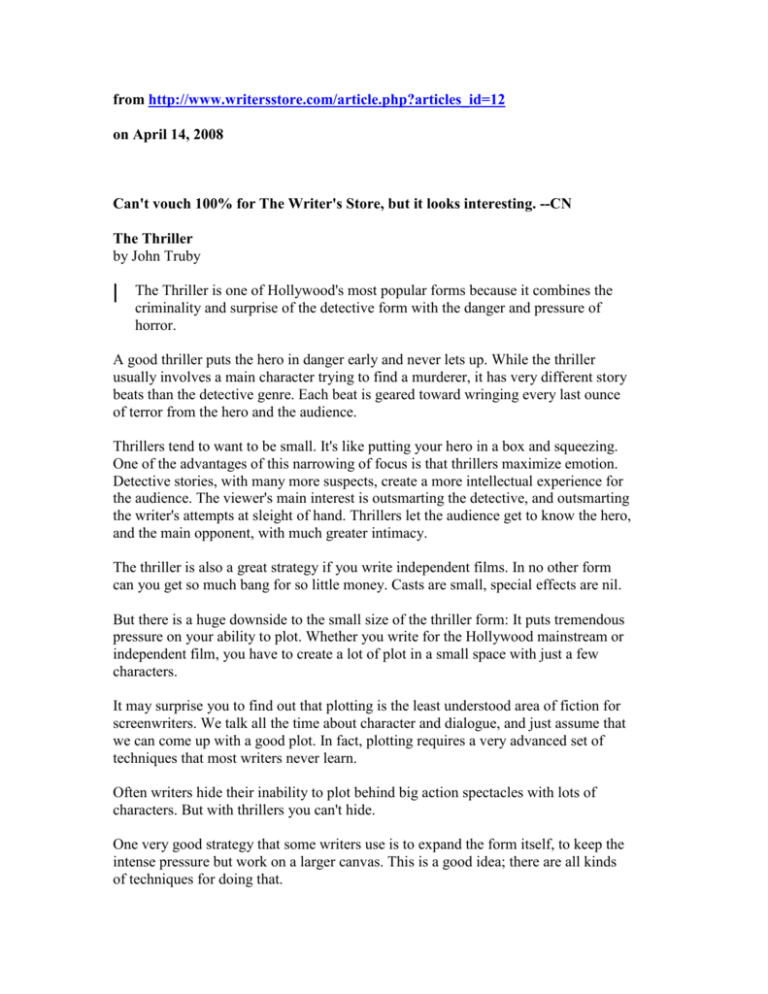
from http://www.writersstore.com/article.php?articles_id=12 on April 14, 2008 Can't vouch 100% for The Writer's Store, but it looks interesting. --CN The Thriller by John Truby The Thriller is one of Hollywood's most popular forms because it combines the criminality and surprise of the detective form with the danger and pressure of horror. A good thriller puts the hero in danger early and never lets up. While the thriller usually involves a main character trying to find a murderer, it has very different story beats than the detective genre. Each beat is geared toward wringing every last ounce of terror from the hero and the audience. Thrillers tend to want to be small. It's like putting your hero in a box and squeezing. One of the advantages of this narrowing of focus is that thrillers maximize emotion. Detective stories, with many more suspects, create a more intellectual experience for the audience. The viewer's main interest is outsmarting the detective, and outsmarting the writer's attempts at sleight of hand. Thrillers let the audience get to know the hero, and the main opponent, with much greater intimacy. The thriller is also a great strategy if you write independent films. In no other form can you get so much bang for so little money. Casts are small, special effects are nil. But there is a huge downside to the small size of the thriller form: It puts tremendous pressure on your ability to plot. Whether you write for the Hollywood mainstream or independent film, you have to create a lot of plot in a small space with just a few characters. It may surprise you to find out that plotting is the least understood area of fiction for screenwriters. We talk all the time about character and dialogue, and just assume that we can come up with a good plot. In fact, plotting requires a very advanced set of techniques that most writers never learn. Often writers hide their inability to plot behind big action spectacles with lots of characters. But with thrillers you can't hide. One very good strategy that some writers use is to expand the form itself, to keep the intense pressure but work on a larger canvas. This is a good idea; there are all kinds of techniques for doing that. But one approach to expanding the thriller I would caution you against -- at least if you want to sell your script to Hollywood -- is writing the political thriller. A political thriller is a thriller in which the crime and the danger have a national or international source and implications. Examples include ‘The 39 Steps,’ ‘The Manchurian Candidate,’ ‘Three Days of the Condor’ and ‘All the President's Men.’ Some very good movies there. But political thrillers are usually much less popular than regular thrillers for five main reasons. I. The national and international implications are often too complicated to explain and make real to the audience in the film medium -- at least in Hollywood films that emphasize speed over content. (This is one reason political thrillers are much more popular in novels.) II. Political intrigue is a shadow world that few can identify with. III. The opposition is a vast system that is almost impossible to focus. IV. The opposition is so powerful that the hero is reduced to the lowest level; he or she is often no more than a chased rabbit. V. Political thrillers typically end badly, with the destruction of the individual by the all-powerful system. John Truby is a screenwriter, a writers' coach, a story consultant, a script doctor and the creator of the story development software 'Write a Blockbuster.' from http://www.filmsite.org/thrillerfilms.html April 14, 2008 THRILLER and SUSPENSE FILMS Thriller and Suspense Films are types of films known to promote intense excitement, suspense, a high level of anticipation, ultra-heightened expectation, uncertainty, anxiety, and nerve-wracking tension. Thriller and suspense films are virtually synonymous and interchangeable categorizations, with similar characteristics and features. If the genre is to be defined strictly, a genuine thriller is a film that rentlessly pursues a single-minded goal - to provide thrills and keep the audience cliff-hanging at the 'edge of their seats' as the plot builds towards a climax. The tension usually arises when the main character(s) is placed in a menacing situation or mystery, or an escape or dangerous mission from which escape seems impossible. Life itself is threatened, usually because the principal character is unsuspecting or unknowingly involved in a dangerous or potentially deadly situation. Plots of thrillers involve characters which come into conflict with each other or with outside forces - the menace is sometimes abstract or shadowy. Thrillers are often hybrids - there are suspense-thrillers, action- or adventure- thrillers, sci-fi thrillers (such as Alien (1979)), crime-caper thrillers (such as The French Connection (1971)), western-thrillers (such as High Noon (1952)), film-noir thrillers (such as Double Indemnity (1944)), even romantic comedy-thrillers (such as Safety Last (1923)). Another closely-related genre is the horror film genre (e.g., Halloween (1978)), also designed to elicit tension and suspense, taking the viewer through agony and fear. Suspense-thrillers come in all shapes and forms: there are murder mysteries, private eye tales, chase thrillers, women-in-danger films, courtroom and legal thrillers, erotic thrillers, surreal cult-film soap operas, and atmospheric, plot-twisting psychodramas. Thrillers keep the emphasis away from the gangster, crime, or the detective in the crime-related plot, focusing more on the suspense and danger that is generated. Characters in thrillers include convicts, criminals, stalkers, assassins, down-on-theirluck losers, innocent victims (often on the run), prison inmates, menaced women, characters with dark pasts, psychotic individuals, terrorists, cops and escaped cons, fugitives, private eyes, drifters, duplicitious individuals, people involved in twisted relationships, world-weary men and women, psycho-fiends, and more. The themes of thrillers frequently include terrorism, political conspiracy, pursuit, or romantic triangles leading to murder. In mid-June, 2001, the American Film Institute in Los Angeles, California made its definitive selection of the 100 greatest American "heart-pounding" and "adrenalineinducing" films of all time, as determined by more than 1,800 actors, directors, screenwriters, historians, studio executives, critics, and others from the American film community. To be eligible, the 400 nominated films had to be U.S.-made, featurelength fiction films, whose thrills have "enlivened and enriched America's film heritage," according to the rules. AFI also asked jurors to consider "the total adrenaline-inducing impact of a film's artistry and craft," regardless of the genre. AFI's list of the 100 Most Thrilling Films are presented by this site. Early Thrillers: One of the earliest 'thrillers' was Harold Lloyd's comic Safety Last (1923), with the all-American boy performing a daredevil stunt on the side of a skyscraper. The haunting and chilling German film M (1931) directed by the great Fritz Lang, starred Peter Lorre (in his first film role) as a criminal deviant - a child killer. The film's story was based on the life of serial killer Peter Kurten (known as the 'Vampire of Dusseldorf'). Edward Sutherland's crime/horror thriller Murders in the Zoo (1933) from Paramount starred Lionel Atwill as a murderous and jealous zoologist. And various horror films of the period, The Cat and the Canary (1927), director Rouben Mamoulian's Dr. Jekyll and Mr. Hyde (1931) with Fredric March, and The Bat Whispers (1930), provided some thrills. Director George Cukor's classic psychological thriller Gaslight (1944) (first made in Britain in 1939 with Anton Walbrook and Diana Wynward) featured a scheming husband (Charles Boyer) plotting to make his innocent young wife (Ingrid Bergman) go insane, in order to acquire her inheritance. The film noir Laura (1944) told about a thrilling murder investigation (for a beautiful missing advertising executive named Laura) conducted by a police detective (Dana Andrews), with suspects including an acid-tongued columnist (Clifton Webb) and a gigolo fiancee (Vincent Price). And the eerie The Picture of Dorian Gray (1945), from Oscar Wilde's masterful tale, refashioned the Faustian story of a man (Hurd Hatfield) who made a deal with Mephistopheles (George Sanders) to forever remain young. A mute domestic servant (Dorothy McGuire) in a haunted house was terrorized by a serial murderer, thinking she was the next victim in The Spiral Staircase (1946). In a taut thriller starring Orson Welles and Rita Hayworth titled The Lady From Shanghai (1948), a beautiful woman, her crippled lawyer/husband and his partner, and an Irish sailor ended up involved in a murder scheme. In Sorry, Wrong Number (1948), an invalid woman (Barbara Stanwyck) overheard a murder plot on the phone against herself. The Third Man (1949), one of the best suspense films of all time, told the story of a writer (Joseph Cotten) in post-WW II Vienna who found out that his old friend (Orson Welles), a black marketeer, was not dead after all. Hitchcock: The Master of Suspense Thrillers No list of suspense or thriller films can be complete without mention of English filmmaker/director Alfred Hitchcock. He helped to shape the modern-day thriller genre, beginning with his early silent film The Lodger (1926), a suspenseful Jack-theRipper story, followed by his next thriller Blackmail (1929), his first sound film (but also released in a silent version). Hitchcock would make a signature cameo appearance in his feature films, beginning with his third film The Lodger (1926), although his record was spotty at first. After 1940, he appeared in every one, except for The Wrong Man (1956). [See all of Hitchcock's cameos here.] Although nominated five times as Best Director (from 1940-1960), Hitchcock never won an Academy Award. Alfred Hitchcock is considered the acknowledged auteur master of the thriller or suspense genre, manipulating his audience's fears and desires, and taking viewers into a state of association with the representation of reality facing the character. He would often interweave a taboo or sexually-related theme into his films, such as the repressed memories of Marnie (Tippi Hedren) in Marnie (1964), the latent homosexuality in Strangers on a Train (1951), voyeurism in Rear Window (1954), obsession in Vertigo (1958), or the twisted Oedipus complex in Psycho (1960). Hitchcock's films often placed an innocent victim (an average, responsible person) into a strange, life-threatening or terrorizing situation, in a case of mistaken identity, misidentification or wrongful accusation (i.e., in The 39 Steps (1935), The Wrong Man (1956), and in North by Northwest (1959)). He also utilized various cinematic techniques (i.e., the first British 'talking picture' Blackmail (1929), the extreme zoom shot of the key in Notorious (1946), the glowing glass of milk in Suspicion (1941), the prolonged cross-cutting tennis match in Strangers on a Train (1951), the virtuoso set-piece of the crop duster in North by Northwest (1959), the montage in the shower sequence accentuated with composer Bernard Herrmann's screeching violin score in Psycho (1960), the dollyzoom shots in Vertigo (1958), or the heightening of anticipation with the long pullback shot from inside a building to the outside and across the street in Frenzy (1972)). Visually-expressive motifs were also his specialty (i.e., the surrealistic dream sequences in Spellbound (1945), the key in Notorious (1946), the staircase or the use of profiles and silhouettes in Vertigo (1958), the murder reflected in the victim's glasses in Strangers on a Train (1951), the concept of "pairs" and guilt transference in Shadow of a Doubt (1943)), or the making of technically-challenging films (such as Lifeboat (1944) and Rope (1948)). [Rope was a film of many 'firsts': it was Hitchcock's first color film and his first film as an independent producer; it was his first film released by Warner Bros.; it was his first and only attempt to make a film appear as a single shot, with a series of ten-minute takes cleverly spliced together; and it was his first film with James Stewart. The basis of the film was the famed Leopold-Loeb case.] In many of his films, there was the inevitable life and death chase concluding with a showdown at a familiar landmark (for example, London's Albert Hall in The Man Who Knew Too Much (1956), the Statue of Liberty in Saboteur (1942), the UN and Mount Rushmore in North by Northwest (1959), Westminster Cathedral in Foreign Correspondent (1940), and the Golden Gate Bridge in Vertigo (1958)). He also reveled in tight and confined spaces, to heighten emotion (i.e., Lifeboat (1944), Rope (1948), or Rear Window (1954), etc.) or restrictive train journeys (i.e., The Lady Vanishes (1937), and North by Northwest (1959), etc). The famed director often capitalized on a 'red herring' or gimmicky plot element to catch the viewer's attention - dubbed a McGuffin (or MacGuffin), that would propel the plot along its course. Usually, the McGuffin initially appears to be of utmost importance, but functions to intentionally misdirect the audience - it then quickly fades into the background and ends up being trivial, irrevelant, or incidental to the film's story. Here is a list of various MacGuffins: The 39 Steps (1935): the nature of the 39 Steps, and the smuggling of secret plans (vital to the country's air defense) out of the country The Lady Vanishes (1938): the coded message contained in a piece of music Rebecca (1940): the character of the first Mrs. De Winter - Rebecca Notorious (1946): the radioactive material (uranium ore) found in vintage wine bottles Strangers on a Train (1951): Guy's cigarette lighter Rear Window (1954): the suspected 'murder' committed by apartment tenant Lars Thorwald (Raymond Burr) North by Northwest (1959): the character of "George Kaplan" (mistakenly thought to be Cary Grant) who is being chased by spies, and the secret microfilm Psycho (1960): the stolen money, the $40,000 wrapped up in a newspaper in the motel bedroom The Birds (1963): the cause of the strange bird attacks Torn Curtain (1966): the secret formula (known by Professor Gustav Lindt) for an anti-nuclear missle device the East Germans have been developing Topaz (1969): what is Topaz? who is it? who is in it? Hitchcock usually cast leading actors against type (Gregory Peck, James Stewart, Cary Grant) opposite cool blondes (Madeleine Carroll, Joan Fontaine, Ingrid Bergman, Grace Kelly, Kim Novak, Janet Leigh, Tippi Hedren) who were often subject to misogynistic abuse, threatening humiliation, or murder. Hitchcock would then explore the darker sides of human nature through the situation, including sexuality and voyeurism, guilt and punishment, or paranoia and obsession. He usually let the viewer know that some horrible event would happen - creating unbearable suspense while viewers waited for the inevitable. Notable examples of Hitchcock's early British suspense-thriller films include The Man Who Knew Too Much (1933), his first great spy-chase/romantic thriller The 39 Steps (1935) with Robert Donat handcuffed to Madeleine Carroll, and the best film of his British period - the mystery The Lady Vanishes (1938). Extending his work into the 1940s in a number of brilliant black-and-white films, Hitchcock continued to perfect his recognizable brand of suspense-thriller, producing Foreign Correspondent (1940), the haunting Oscar-nominated Rebecca (1940) about the strange romance between a young woman (Joan Fontaine) and an emotionally-distant rich widower (Laurence Olivier) - overshadowed by a vindictive housekeeper (Judith Anderson), Suspicion (1941) about a woman in peril from her own husband (cast against type Cary Grant), Saboteur (1942), Shadow of a Doubt (1943) - Hitchcock's own personal favorite and based upon the actual case of a 1920s serial killer known as 'The Merry Widow Murderer', Spellbound (1945), and Notorious (1946). In the 1950s, Hitchcock added technicolor to his still-brilliant dark and moody films, now with exotic locales and glamorous stars. He reached the zenith of his career with a succession of classic films: the suspenseful black and white Strangers on a Train (1951) about two train passengers: tennis pro Guy (Farley Granger) and Bruno (Robert Walker), who staged a battle of wits and traded murders with each other Dial M For Murder (1954), with Ray Milland as a villainous husband who attempts to murder his wealthy wife (Grace Kelly) - also shot in 3-D Rear Window (1954) - a masterful study of voyeurism confined to a Greenwich Village apartment complex and courtyard, with Grace Kelly as a seductive girlfriend to beau James Stewart To Catch a Thief (1955), a lightweight thriller set in S. France The Man Who Knew Too Much (1956) - a remake of Hitchcock's own 1934 spy thriller Vertigo (1958), one of Hitchcock's greatest films, with James Stewart as a retired police detective who becomes obsessed with the disturbed enigmatic 'wife' (Kim Novak) of an old friend and the entertaining, romantic comedy/spy thriller North By Northwest (1959) about an advertising executive (Cary Grant) mistakenly acquiring the identity of a fictional governmental agent, and his encounter with an icy blonde Eva Marie Saint After Hitchcock's classic films of the 1950s, his films were wildly uneven, although he produced the shocking and engrossing thriller Psycho (1960) about a loner mother-fixated motel owner and taxidermist - with the classic set piece (the 'shower scene'), and the suspenseful and strangely terrifying The Birds (1963) about a invasion of birds in a N. California coastal town and its effect upon archetypal cool blonde Tippi Hedren. His film Frenzy (1972), Hitchcock's first British film in almost two decades, was given an R rating for its vicious and explicit strangulation scene.

